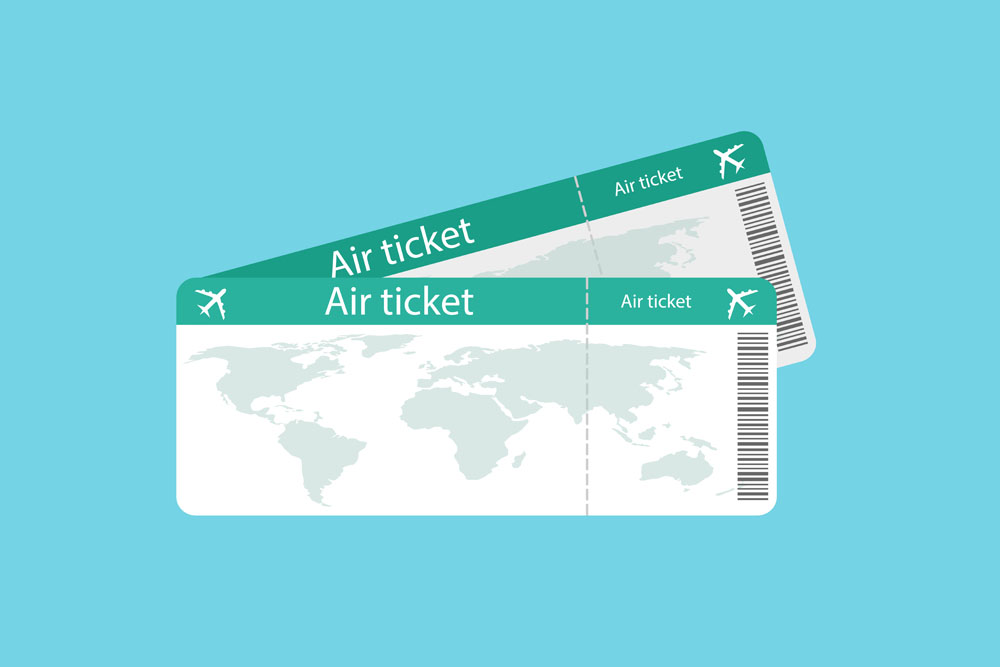
Finding cheap flights can sometimes be a tedious process, but if you use the right tools and tricks you can speed up your searches a lot. Not only can you save yourself a lot of time, but often also a lot of money.
Here are a few tips for finding cheap flights that will turn you into a flight-searching ninja!
Use multiple flight search engines
If you already have a destination in mind and just want to find the cheapest options, it’s best to use a meta-flight search engine (one that searches all airlines and agents).
These are some great flight search engines:
Google Flights — a bit bare-bones but it’s a good research tool
Momondo — has some great tools for knowing seasonal prices, among others (see later)
Skyscanner — one of the first flight search engines, can also be useful to check
Kiwi — while it’s not recommended to book with them, it’s a flight search engine with a lot of useful tools, including the ability to combine two separate tickets with two airlines into one itinerary
I’ll use Kiwi a lot in the examples here, but you can use any search engine. I actually recommend using them all because they show different listening, and each has different search tools.
Personally, I use a minimum of two search engines whenever I’m researching a trip.
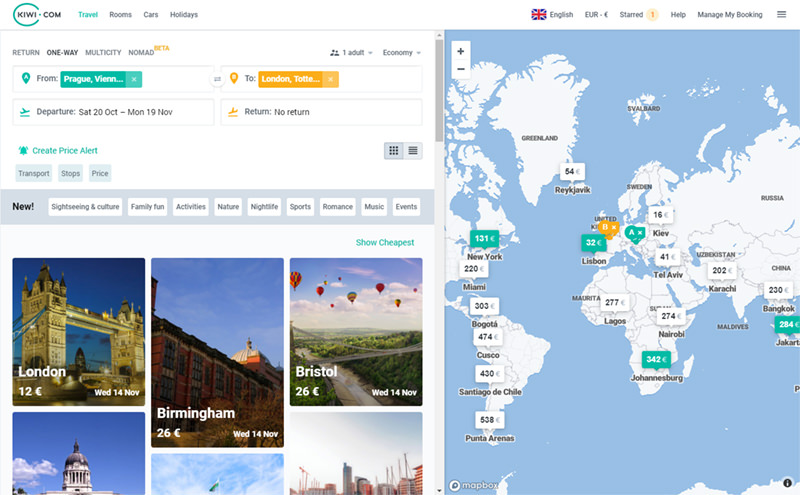
But… always book direct!
While these search engines are super helpful, they often refer you to absolutely terrible booking sites.
Google Flights, Skyscanner, and Momondo usually link to third-party websites where you can book the tickets. Unfortunately, some of these have horrendous reputations for customer service. 100% avoid Opodo, GoToGate, eDreams, MyTrip, and similar sites.
They may seem OK, but things quickly fall apart if you need to make a change, cancel, or get a refund. I’ve had hair-pullingly frustrating experiences with several of these.
Kiwi can be problematic as well. I once had to add extra luggage allowance to a ticket I’d already booked with them and they charged 3 times more than what the airline itself charges if you book with them directly.
It’s usually better to deal with airlines themselves than with intermediaries. As another example, I once had to cancel a flight I’d booked via GoToGate. The airline itself offered free cancellations, but the site I booked it through did not pass on that offer of free cancellation, only refunding a pitiful $5 of the ticket price.
Pro Tip: use search engines to find cheap flight options, but then always book directly with the airline. This may cost slightly more, but can avoid some horrible headaches! I learned this the hard way and now only ever book direct.
Finding cheap places to fly
Do you want to fly somewhere cheap but you’re not sure where yet?
Well, you can get a rough idea of the prices.
Just try entering ‘anywhere‘ in a search box on Kiwi, Skyscanner or Momondo. Hit the search button and you’ll see a beautiful map with estimated prices.
You’ll get a map that looks more or less like this.
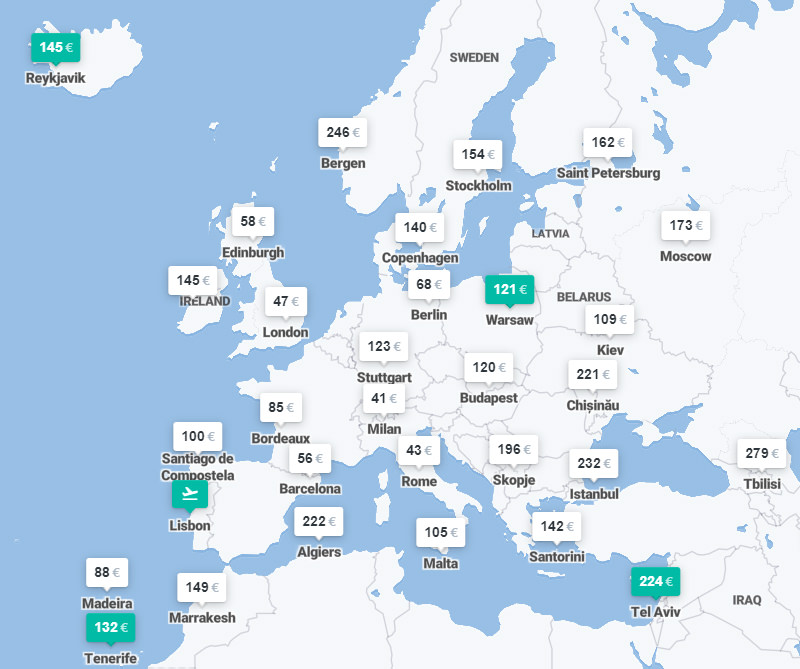
Finding cheaper airports to fly to
As you may already know, flexibility is key when it comes to finding cheap flights. The less attached you are to particular dates, airlines, or airports to fly into, the cheaper you can fly.
If you already know your origin and destination, you can increase your chances of finding a good deal by including nearby airports.
This used to be a tedious manual process, but I like using Kiwi for this as it makes it easier to include a geographic range within which you’d like to search.
There are two ways to do it:
- Click on a destination you’ve already set
Right-click and select Expand to Radius - Draw a circle on the map
Right-click anywhere and select ‘Flight to here’.
In both cases, you’ll now get a catchment circle that you can expand or contract depending on how flexible you’re willing to be.
Here’s an example of a radius search.
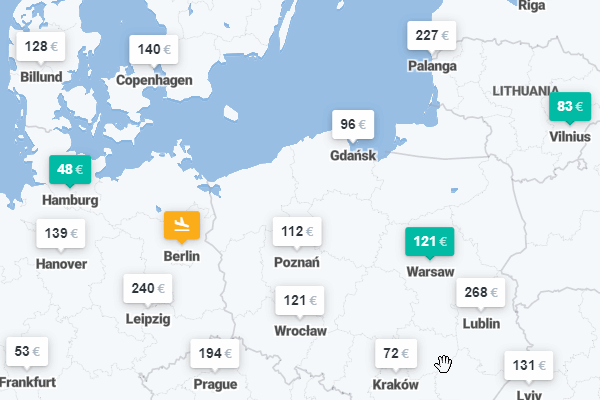
Why look for other airports?
Well, the cheapest airport to fly to is not always the most obvious one.
For example, if you’re flying to Malaysia, it might be much cheaper to fly into neighbouring Singapore instead of Malaysia’s capital of Kuala Lumpur.
If you’re going to Albania, you’ll often have better luck flying into Curfu in northern Greece than to Tirana, which has only a small airport.
And if you’re going to Amsterdam in the Netherlands, it might be much cheaper to fly into Eindhoven (a small airport in the south) and then taking a train.
Finding the cheapest day to fly
If you already know roughly when you want to travel, then changing your departure and return by just a few days can give you huge savings.
You can do this manually, of course. Often I just brute-force things by trying loads of dates and keeping a billion browser tabs open.
However, the search engines can also help you try more departure and return dates.
There are two ways to do it:
- View prices in the calendar
With a departure and destination airport already set, click the date field to see lowest prices for each day.
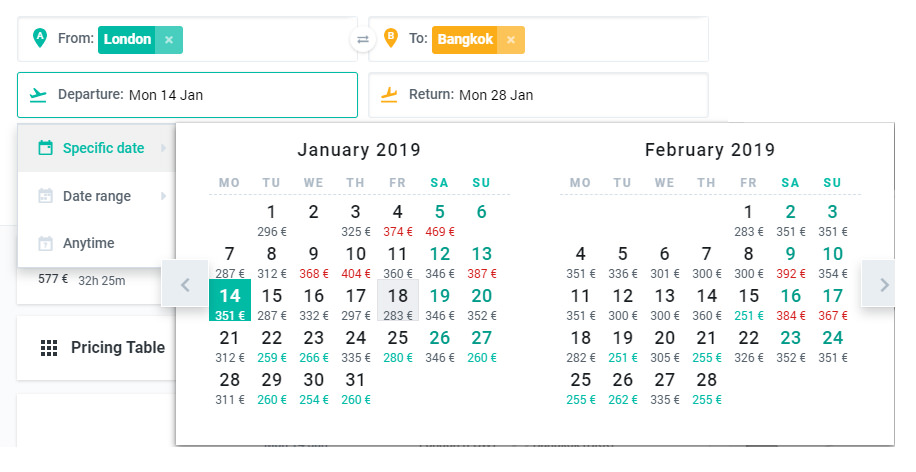
- Make your search flexible
With your departure and destination airport selected, click Date Range and/or Time of Stay.
Kiwi or your other chosen site will now search for the cheapest flights at any time within the limits given.
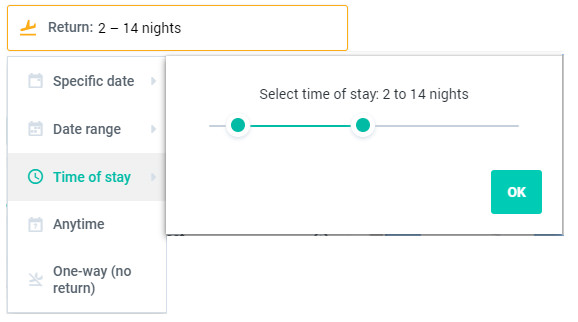
As a rule of thumb: Sundays and Wednesdays are often good days to search for flights. Sundays have the fewest business travellers. Not many tourists or commercial travellers will travel mid-week either. If you have a bit of flexibility with your dates, you can often make huge savings.
If your job allows, consider working remotely for a couple of days so you can travel later/earlier.
Finding the cheapest time of the year
Okay, so the above trick is nice for optimizing your departure and return dates when you already know roughly what time of year you’ll be going.
But what about viewing the bigger picture?
How could you know what time of the year is the cheapest to go?
After all, some destinations are highly seasonal, with flights becoming easily twice as expensive during certain months. A great example is the month of August all throughout Europe when many people take their summer holiday and prices go through the roof. Going in the shoulder or off-season can save you a ton of money.
My favorite way of finding this out is with Momondo, which has a cool feature called Flight Insight. This lets you take a deep dive into the cost variables for a particular route.
Here’s how to use it:

- Search for your intended flight route using any calendar date. Then click ‘Flight insight for [origin city] to [destination city]’ in the top right corner. (This is not yet available for every route.)
- See a graph showing all the factors affecting price, including seasonality, time of booking, day of the week, and airport.
- Hit the Seasonality tab for a graph showing the cheapest and most expensive months of the year to travel this route.
Adding a layover for a cheaper trip
Besides being flexible with my dates, my other favorite way of getting cheaper airfares is by adding a layover — a short stay in a transfer city on your way to your final destination.
You can often get different and much cheaper results by adding one to your flight searches.
Besides potentially giving you cheaper fares, layovers are really fun to add to your trip! You get to sample another destination on your way somewhere else, adding more variety.
Some examples of fantastic layovers I’ve done:
- Visiting Istanbul on my way to Georgia (with Turkish Airlines)
- Flying home from Thailand via Beijing and spending a couple of days there
- Flying to Albania via Athens, adding this historical city to my Albania beach trip
Don’t forget about layover opportunities! Seeing a 24h flight option may lead you to dismiss it out of hand, but it could be an amazing chance to see another city on your trip. You can even extend your time in the layover destination so you get more time to check it out.

There are some specific tricks to planning a layover, but when you’re searching for flights and you notice a city being a stopover anyway, try explicitly adding that stopover to your search. You can also try a multi-stop itinerary with this city added in. Often, this will reveal additional fares, some of which may include long (24hrs+) stays in the stopover.
Some popular air travel hubs offer special layover deals, such as free hotels or tours. For instance, I’ve stayed for free for 2 nights in a 3-star hotel in Istanbul, and for 2 nights in a 4-star hotel in Abu Dhabi. All you have to do is fly with a specific carrier, such as Turkish Airlines, and spend a minimum number of hours en-route.
For more on such layover hacks, don’t miss my video below:
Planning the best multi-stop route
Okay, hold onto your hat, as we’re about to enter power mode.
Want to add some incredible layovers?
Are you planning a round-the-world trip?
Or are you a digital nomad spending a month here and there depending on price?
Then multi-stop searches are your friend!
Most flight search engines have these, but Kiwi has a more advanced version called the Nomad search. It’s like making a wishlist of destinations and letting the search engine figure it all out.
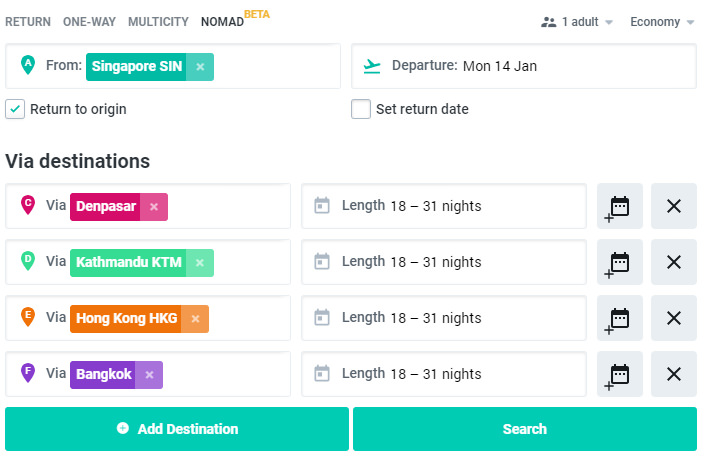
With Nomad search simply enter the places you want to go, select roughly how long you want to stay there, and Kiwi will take care of the rest. It will figure out the ideal time, order, and flight paths to get you the cheapest possible total package.
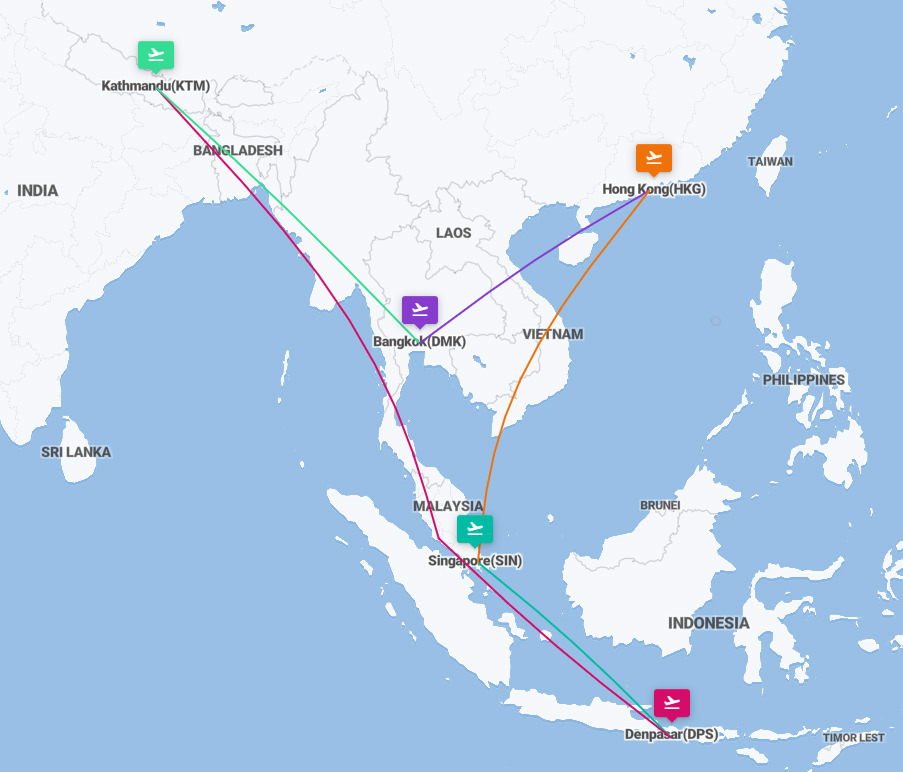
Combining two seperate single fares
Two one-way trips with different airlines can sometimes be cheaper than a normal return with one airline.
Kiwi is specialized in creating such ticket combinations — something they call ‘virtual interlining’. This means it sometimes displays multi-stop flights with multiple carriers (that don’t already work together through a codeshare).
The only downside is that if Flight A gets cancelled or delayed, you may not be entitled to a refund or rescheduling for unrelated Flight B, because they are separate companies. Luckily, for these situations, Kiwi offers its own guarantee.
To be clear, if you see this:
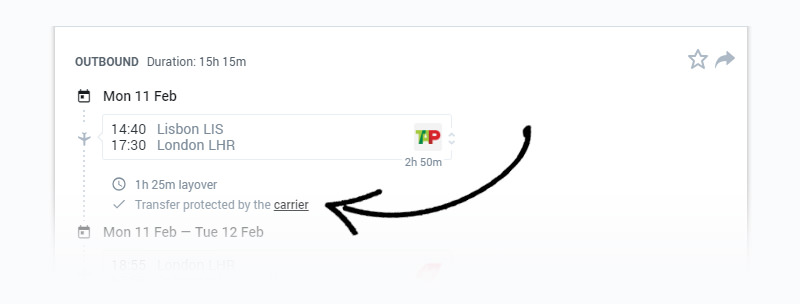
Then the flights are a normal one-package kind of deal. (It says “Transfer protected by the carrier.”)
But if you see this:
Then it means Kiwi got creative and put together two single tickets that normally aren’t sold together. (It says “Transfer protected by the Kiwi.com Guarantee”.
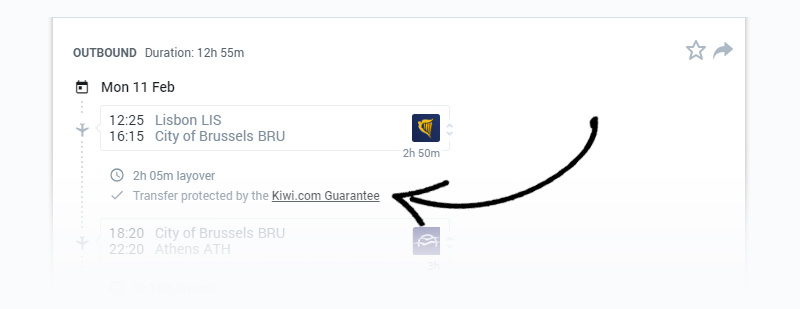
Now, I should mention that Kiwi’s customer service isn’t always stellar, and I usually recommend booking with the airlines directly. But in this case, you could consider a combined ticket offered by Kiwi if the price difference is significant.
The best time to book
There are a lot of theories as to the best time to book a flight to secure the best price.
According to research published by both Skyscanner and Momondo, the optimal time frame to buy tickets is 5 to 6 weeks ahead of departure.
However, my personal rule is that the best time to book is when you find an amazing deal.
I don’t think it’s a good idea to just sit around waiting until it’s exactly 6 weeks until departure. The key to a good price is typically not to leave it waiting until the last minute.
I have often kicked myself for not booking what was clearly an awesome deal, then seeing the prices go up a week or two later. I’ve had even worse situations where I was about to book a flight but left it to the next day. This just so happened to be when a promotion ended so my flight ended up being over $400 more expensive!
Nowadays when I see a flight that seems perfect for my trip and I’ve already done a lot of research, I just go for it. Being a fence-sitter rarely pays off.
The worst time to book is within 14 days of flying, so don’t leave it too late.
No, you don’t get cheaper fares by using Incognito mode. I’ve gotten so much flack for saying this, but it’s really just a myth. (Consumer Reports even investigated and debunked it. The U.S. Department of Transportation has also stated they’ve found no evidence of this practice.)
However, airlines do use dynamic pricing which can be highly annoying. All it may take is for a couple of seats to be sold for the remaining seats to jump in price significantly. This is why waiting longer for a better price can often lead to disappointment.
P.S. How to know about hidden deals
Besides flight search engines, there are a few sites and services dedicated to finding unusually cheap deals. Often these are ‘mistake fares’, which occur when airlines misprice a certain flight. Finding these is very difficult, but some sites employ whole teams of searchers to find them!
If you are US-based, the best site for knowing about these often ridiculously cheap flights is Going (forwerly known as Scott’s Cheap Flights). You can set your home airport and where you’d like to go, and Going will alert you to the best deals.
You can sign up to Going for free. There is also a paid premium version with more/better deals.

Outside the US, sites like Secret Flying and The Flight Deal are good ones to check.
Sometimes these super cheap flights take extra stops or are via obscure routes, but the deals can be crazy good.
I once flew from London to Panama and back for just over $300 thanks to Going. I’ve seen Amsterdam to Guatemala return for 228 EUR and many other insane fares. The only catch is that these deals are often not around for very long — sometimes just for a few days — which is why the sites scouring for these special deals can give you the heads-up.
And there you have it — all my best tips for finding affordable airfare. Don’t miss my other budget travel tips here for finding cheap accommodation or inexpensive countries to travel to.
